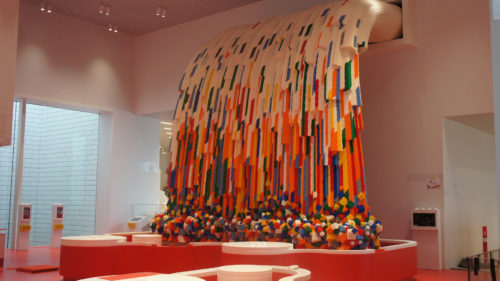
This month’s featured case study comes from UM Australia. Shortlisted at both the Festival of Media Asia and Global Awards, “Using Mobile to Put the ‘Toy’ Back Into Toy Sale” unlocked the potential of Mobile for Australian retail.
UM Australia “Using Mobile to Put the ‘Toy’ Back Into Toy Sale”
This is the story of how a retailer defied category conventions, and became the beacon of play in a retail sea of ‘sales’. An Australian first in attitude, behavior and execution.
You might expect the toy category to be full of excitement, but over the years Australian toy sales have lost their spark of imagination and fun. Retailers viewed ‘toy’ like every other event; rational with price as the main driver. Far too much focus on the ‘Sale’, and not enough on the ‘Toy’.
During the Toy Sale event category spend is high, grabbing attention is difficult, keeping it near impossible. Reach and frequency become the main levers, but our analysis found this didn’t trigger familiarity and preference. Our approach was to focus on quality of interactions, rather than volume, to increase the consideration of Target by 4%. A tough ask in a competitive landscape.
The Challenge: If any brand was positioned to do things differently, it was Target. Known as one of the most fun, energetic and vibrant retail brands in Australia, their usual playful essence was exactly the kind of spark that was missing from Toy Sales. By tapping into these values we make toys the rightful hero again. Take the focus away from price; away from ‘sale’. Put fun, play, and engagement front and center. It’s time Australia got more playful.
The Strategy: Understanding the buying process of any category is hard, especially one with the complex sales dynamic of mums and kids. To get to grips with the role toys play within the household we, well, became part of their family. Conducting ethnographic deep-dives to discover how people use toys, decide which to buy, and when they actually buy them.
The behaviors that we discovered were fascinating. The continued price focus of Australian retailers has actually changed the buying behavior of moms, causing them to see toy purchasing with a much more rational focus. Yet, deep down we never really grow up. We all want to act like a kid sometimes; jumping in puddles; wanting to play rather than work. Parents hadn’t lost the art of play; they’d lost the ability to see toys the way kids do; unashamed fun, playful, with limitless opportunities everywhere they look.
Mom’s rational behavior was further reinforced by the traditional channel conventions of retailers. Catalogue and point-of-sale material were the key channels for product/price information. To ignite the possibilities of play we needed a different approach.
Our idea was shamelessly simple. Remove the packaging. Remove the barriers. Take the toys out the box and allow mom to interact with them. Harness the potential of play, and bring it straight to mom in the most engaging and convenient way; her smartphone.
Where retailers put traditional channels at the heart of their schedule, we put the phone. Mobile by its very nature allows play both at home and in-store with an unmatched level of interactivity. Smartphone penetration in Australia, and with moms, is one of the highest in the world.
The Execution: Our app put the ‘Toy’ back into ‘Toy Sale’, inspiring the audience with a series of magical experiences unlike those ever offered by an Australian retailer before.
Static catalogues, point of sale, and even outdoor posters were turned into interactive, living and breathing 3D experiences through a simple scan. A Lego City suddenly springs to life with a scene of robbers escaping, while police cars and helicopters chase after them. The Teenage Mutant Ninja Turtles van appears and starts to perform doughnuts. The potential of play became impossible for mom to miss. Parents and kids were brought together in the play experience before they even bought the toy.
The level of play continued across the whole app, with each section designed to build engagement and excitement. There was a huge ‘fun zone’ full of entertaining content, branded videos and wallpapers. Kids could even build a wish list of their favorite toys, helping to push moms through to the Target website and store.
Users were also rewarded for their interactions, by collecting 3D experiences from point-of-sale materials or catalogues they could win a large prize of toys from Target.
By linking the app with the catalogue and in-store experience, we made sure that the campaign was integrated throughout the shopping process.
The Results: During the campaign we increased mom’s consideration to shop by 14.1% month-on-month, against a target of 4%. Brand familiarity went up by 2%, from an already significant base. Our interactivity scores were exceptional; ensuring we not only attracted attention, but kept it. For the first time in Australian retail history the Toy Sale was entertaining and interactive, exactly as it should be.
- Over 28,000 downloads in the first month. 3.2% of the eligible target audience.
- Number 3 in the iTunes Entertainment category.
- Over 151,000 magical animations.
- Over 566,000 mobile page visits.
- The average user recorded 28.5 engagements and/or page views.
- The average time spent on each engagement was over 3 minutes.
That’s a total of 711,000 minutes, or 493 days of engagement delivered in one month. Magical moments ignited from the traditional catalogue format equated to 15,800 episodes of the Australian kids’ favorite show, The Wiggles!
Not only did we bring to life the Toy Sale through catalogue and product integration, we changed the way traditional Toy Sales are delivered, by recognizing and unlocking the potential of Mobile for Australian retail.
CLICK HERE to check out the engaging Toy Sale video.



